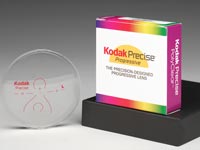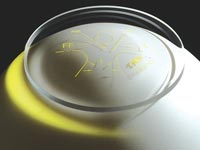Progressive-addition lenses cater to active lifestyles
Contact Lenses and Eyewear
As baby boomers age into presbyopes, the latest generation of progressive-addition lenses (PALs) addresses the unique needs of this demographic. The newest PAL designs are geared toward the active lifestyles of today’s presbyopes, with particular emphasis on minimizing peripheral distortion.
Several new PAL products feature designs that are specially adapted to meet the demands of presbyopes who seek superior comfort, acuity and freedom to maintain their activities and habits.
The Zeiss Gradal
The newest PAL from SOLA Optical (Chester, Va.) is the Zeiss Gradal Individual, according to company spokesperson Jeff Hopkins.
“Zeiss Gradal Individual harnesses the potential of advanced free-form technology to deliver what has never been possible before: a lens design that is optimized for each individual patient,” Mr. Hopkins said in an interview with Primary Care Optometry News.
“Traditional semi-finished lenses are limited by the number of base curves they can offer,” he said. With traditional lenses, each base curve must cover a range of prescriptions, but can only be optimized for a few of the prescriptions in that range.
“Using free-form technology, Gradal Individual is able to create an optimized design for each individual prescription,” he said. “As a result, Gradal Individual virtually eliminates astigmatic errors and offers wider clear central viewing areas.”
In addition, Mr. Hopkins said Gradal Individual also gives dispensers the option of taking additional measurements for the chosen frame as worn by the patient. The design can be optimized for vertex distance and pantoscopic tilt, as well as the patient’s preferred near vision working distance.
“The result is a design that is tailored not just for the individual’s prescription, but for his or her frame choice and visual habits,” he said.
For small-frame wearers, a short-corridor version of Gradal Individual is available. This version, called Gradal Short I, is available in a 1.6 index.
Mr. Hopkins said the greatest visual gains with the Gradal Individual will be realized by patients with higher sphere powers or cylinder power or who choose a frame with a vertex distance or pantoscopic tilt that is outside the normal range. “Zeiss Gradal Individual will give every wearer the best possible vision for his or her individual circumstances,” he said.
|
| |
|
| |
|
|
Kodak Precise Lens
The Kodak Precise Progressive design is the newest PAL offering from Signet Armorlite (San Marcos, Calif.), according to Mary Howland Stowell, Signet Armorlite’s optical engineer. This lens is made with the company’s proprietary technology, Vision First Design.
“With this technology, the traditional design methodology is actually reversed,” she said in an interview. “Instead of calculating the lens surface and then measuring the results, Signet Armorlite designers started by defining the optical properties that constitute superb vision and letting those calculations determine the corresponding lens surface.”
Ms. Stowell said this approach provides direct control over the curvature of the lens, which determines the refractive power at every point on the lens. “When you can do that, you can generate a design with a smooth, continuous power increase across the entire lens, top to bottom,” she said.
Smooth power progression results in improved visual performance, including stable peripheral vision and rapid recognition of objects in the periphery, she said.
In addition, Ms. Stowell said, horizontal symmetry in the distance and peripheral areas promotes good binocular vision. Combined with the smooth power progression, this produces visual effects similar to a single vision lens.
Ms. Stowell said the Kodak Precise lens is recommended for frame selections down to a 20-mm fit height. In a test market conducted by Signet Armorlite’s Optometrist Advisory Board, the design offered rapid adaptation for driving, reading and everyday activities among various types of presbyopes.
Shamir Insight Attitude
Shamir Insight Inc. (Kibbutz Shamir, Upper Galilee, Israel) has introduced Attitude, a line of PALs designed to provide quality visual acuity in fashionable wrap-around frames.
Using proprietary Eye-Point Technology, these lenses employ surface asphericity to compensate for off-center, unwanted astigmatism that can occur when grinding a prescription ranging from –4.00 to +2.00 D in a base 8 lens.
“Choosing a base curve that is not optimized for the desired prescription will result in increased unwanted astigmatism, according to Raanan Naftalovich, CEO.
By simulating the human eye, Eye-Point technology provides Attitude with the optimal aspheric computations, resulting in a lens with base 8 curvature while optically acting as an optimized base 3 or 5.
Physio and Physio 360
Essilor of America (Dallas) has developed two new progressive lenses, Varilux Physio and Varilux Physio 360.
These lenses use a patented new manufacturing process called Wavefront Advanced Vision Enhancement (WAVE), according to company spokesperson Alison McCleskey.
Through WAVE technology, Essilor has adapted the wavefront technology used in laser surgery to correct vision by detecting and even eliminating many surface distortions, Ms. McCleskey told Primary Care Optometry News.
“For the first time, Varilux engineers can analyze the entire beam of light entering the pupil – not just a single ray – and control the quality of the wavefront passing through the lens to achieve optimal acuity,” she said. “WAVE technology uses patented, proprietary software in both lens designs to scan the entire surface of the lens, calculating the targeted optical function for each gaze direction.”
With Varilux Physio 360, WAVE technology is applied to both the front and back of the lens with 360° Digital Surfacing. This minimizes distortions, preserving and enhancing the effectiveness of the front design.
Developed by Essilor, 360° Digital Surfacing combines a patented calculation engine to optimize design, as well as a patented digital surfacing manufacturing process to produce the back side surface of the lens, according to Ms. McCleskey.
Hoyalux iD
Hoya Vision Care (Lewisville, Texas) produces the Hoyalux iD, a progressive lens that provides a short corridor length and the widest distortion-free visual surface for all distances, according to the company’s Web site.
The lens reduces skewed distortion through Hoya’s Skew Deformation Index Calculation, which is a virtual evaluation technique that allows for the recalculation of the most disturbing distortion. The effects of image distortion from oblique peripheral vision are quantified at every position on the lens and corrected through calculation, according to the company.
Hoyalux iD is created using FreeForm cutting technology and a proprietary Bi-Aspheric/atoric FreeForm polishing technique.
The two surfaces minimize distortion in front of the eye, creating a large distortion-free zone.
Rodenstock Progressiv Life 2
Rodenstock Progressiv Life 2 is Rodenstock USA’s (Columbus, Ohio) latest PAL. This lens provides a “position of wear” design that offers the patient accurate visual acuity in all viewing areas of the lens.
It provides a thinner, flatter profile than its predecessor and less peripheral astigmatism. It also features a progressive zone that is 15% to 30% wider than the earlier design.
The Progressiv Life 2 is available in the following materials: 1.5, 1.6 and 1.67 plastic and photochromic ColorMatic.
For more information:
- Jeff Hopkins is a spokesperson for SOLA. He can be reached at Carl Zeiss Vision, 13017 N. Kingston Ave., Chester, VA 23836; (804) 530 5851; fax: (804) 530 8322; e-mail: jhopkins@sola.com; Web site: www.solaoptical.com.
- Mary Howland Stowell is an optical engineer at Signet Armorlite. She can be reached at 1001 Armorlite Dr., San Marcos, CA 92069; (800) 759-4630; fax (760) 471-6255; Web site: www.signetarmorlite.com.
- Alison McCleskey is public relations/advertising specialist for Essilor of America. She can be reached at 13515 North Stemmons Freeway, Dallas, TX 75234; (800) 215-7249; fax: (800) 877-0328; www.essilorofamerica.com.
- Raanan Naftalovich, CEO for Shamir Insight can be reached at 7726 Clairemont Mesa Blvd., San Diego, CA 92111; (888) 707-7760; fax: (877) 285-4863; e-mail: skohn@shamirlens.com; www.shamirinsight.com.
- Hoya can be reached at 3400 Edison Way, Fremont, CA 94538; (510) 252-8370; fax: (510) 490-1988; www.hoyavision.com.
- Rodenstock can be reached at 814 West 3rd Ave., Columbus, OH 43212; (888) 407-3937; fax: (888) 407-3938; www.rodenstockusa.com.



